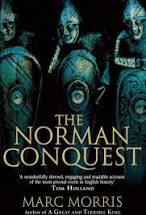The Norman Conquest
I
learned about the Norman Conquest when I was in school and know the date 1066.
But schoolchildren in Britain probably learn more about it than I did in the
United States. At least that’s the impression I got from the introduction. In referring to the Bayeux Tapestry, Morris
writes, “perhaps the most famous and familiar of all medieval sources, at least
in England, where we are introduced to it as schoolchildren, and where we
encounter it everywhere as adults: in books and on bookmarks, postcards and
calendars, cushions and tea towels, key rings, mouse-mats and mugs.” I have
heard of this tapestry (which is really an embroidery), but never learned about
it in school. It is familiar-looking to me, but I have never studied it
closely.
That
has now changed. After reading this book, I have a new interest in this
incredible piece of work and find it fascinating. This book is not about the
Bayeux Tapestry, of course, but it does refer to it often and also explains
many of the scenes and symbols woven into it, which are related to the Conquest.
Morris
begins the story of the Conquest long before the conquest – with information
about King Edward, known as Edward the Confessor, who was the king of England
from 1042 to 1066. As Morris writes, “…in order to understand that story [of the conquest] properly, we need to travel back to
his youth, and explore how he came to be king of England in the first place.” He
details the background leading up to the battle: the people involved; how they
got where they were; the events that shaped them and that influenced the
invasion.
And
the story continues for many years after the conquest. I had always thought of
the Norman Conquest as something that happened at the Battled of Hastings in
1066; William won and became king, and then it was over and England was ruled
by Normans. But it seems that 1066 was just the beginning of many years of
change brought about by the Norman invasion. So not only does the book explain
the many trials and tribulations William the Conqueror had for the rest of his
reign, but also summarizes the kings who succeeded him – up to Henry III, the
father of the future Edward I, who would be “the first king of England since
the Conquest to bear an English name, speak English and lead a united English people.”
So the chapter about the invasion and battle (chapter 11) is in the middle of
20 chapters.
Marc
Morris writes in such an interesting style that the book reads like an
adventure novel. It is detailed without being too academic. He clearly explains
who people were, what is known about them, and what can be assumed from the
records of that time and later historical records. I appreciate the way he not
only presents differing accounts, but relates enough information about them to
justify why one or the other is likely to be more reliable.
Some
of the changes brought about by the Norman invasion included, of course, the
change of official language and documents from English to Norman French. But
other changes included the building of castles (which hadn’t really existed
before in England), the establishment of forests (which also hadn’t existed –
in fact, the word itself is from Norman French), and the extent of slavery and
the slave trade in England (which the Normans eventually ended).
The
two sets of photos and illustrations are a good addition to the book – scenes
from the Bayeux Tapestry and of examples of English and Norman architecture.
The book also includes an extensive set of notes for each chapter and a
bibliography of both primary and secondary sources.
I
found this book to be an extremely interesting read, and think it would appeal
to readers who are interested in history, perhaps English in particular, and in
the impact that specific battles have had on Europe and ultimately the world.


Comments
Post a Comment